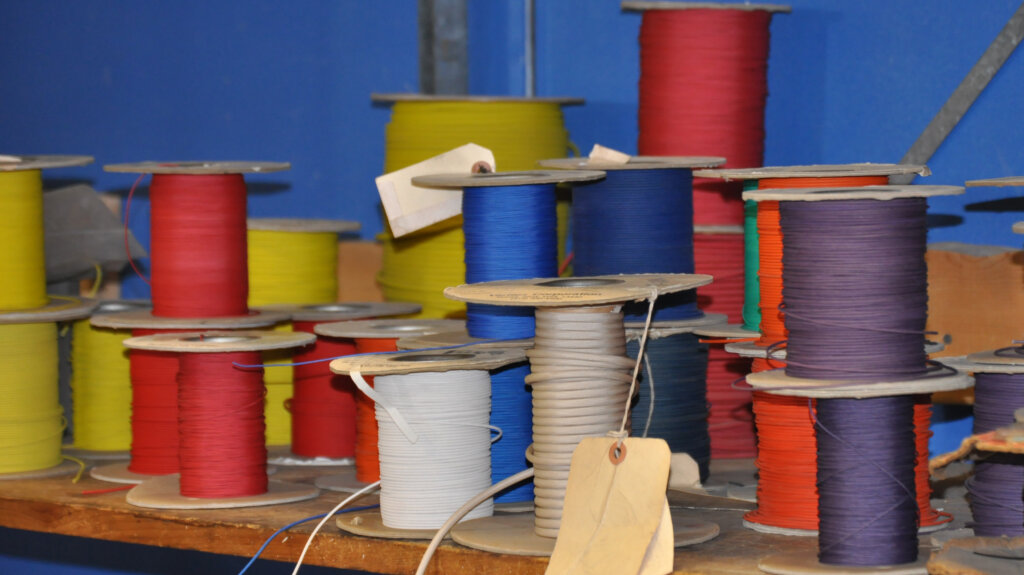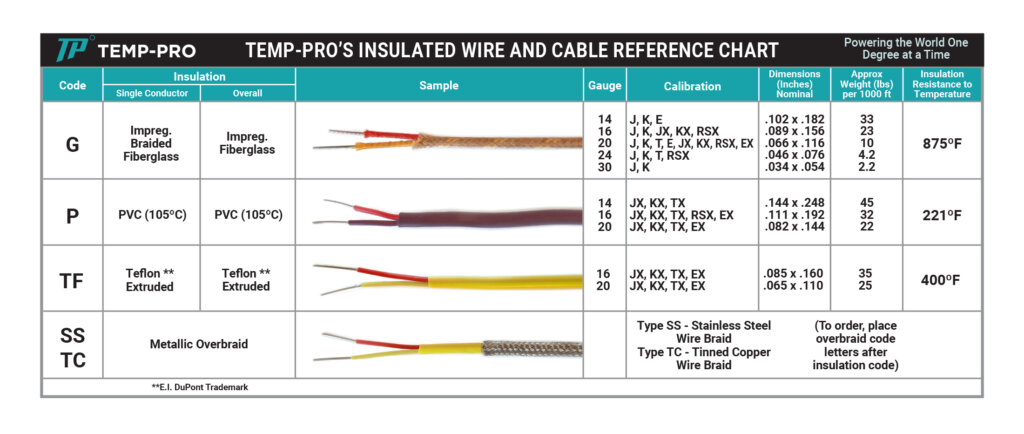 Temperature sensing is crucial in various applications, including industrial processes, research laboratories, and medical equipment. For accurate temperature measurement, thermocouple wires have become the go-to solution for many industries. This article will explore the essentials of thermocouple wires and thermocouple extension wires, including their types, insulation, error limits, and maximum length for temperature sensing.
Temperature sensing is crucial in various applications, including industrial processes, research laboratories, and medical equipment. For accurate temperature measurement, thermocouple wires have become the go-to solution for many industries. This article will explore the essentials of thermocouple wires and thermocouple extension wires, including their types, insulation, error limits, and maximum length for temperature sensing.
The Difference Between Thermocouple Probes and Thermocouple Wire
Thermocouple probes and thermocouple wires both measure temperature, but they have different structures and applications. Thermocouple probes typically have a metal sheath and a thermocouple sensor at the tip. This design makes them more suitable for taking temperature readings in liquids, gases, and hard-to-reach areas. On the other hand, thermocouple wires are used to extend the thermocouple sensor’s reach or to build custom sensors to fit specific applications.
Our modern, flexible manufacturing plant is capable of supplying all types of insulation, grades and wire calibrations primarily from its large stock of insulated materials. Standard insulation as well as thermoplastic and fibrous materials, and metallic over braids are all available. Our wires are made of the highest quality materials ensuring maximum accuracy.
How to Identify Insulated Thermocouple Wires
Wire insulation of all kinds is color coded. Color coding in thermocouple wire insulation in particular is a useful way to identify the wires’ characteristics, such as the type of thermocouple and polarity. The ASTM International and International Electrotechnical Commission (IEC) are globally recognized for setting the accepted color codes standards. For instance, in the United States a type K thermocouple has red wire and one yellow wire, typically with a brown overall jacket. A type K extension grade wire also has one red wire and one yellow wire, but it has a yellow overall jacket.
The Difference Between Standard Limits of Error (SLE) Wire and Special Limits of Error (SPE) Wire
Thermocouple wires have two error classifications: standard limits of error (SLE) wire and special limits of error (SPE) wire. SLE wire has wider temperature ranges and error limits, making it suitable for general-purpose temperature measurement applications. SLE wire’s temperature range is between -328°F and 2282°F (-200°C and 1250°C) with an error limit of ±2.2°F (±1.2°C).
Special limits of error (SPE) wire has tighter temperature ranges and error limits, making it more accurate for critical temperature measurement applications. The temperature range for SPE wire is between -328°F and 2192°F (-200°C and 1200°C) with an error limit of ±0.9°F (±0.5°C). It’s important to note that SPE wire is more expensive than SLE wire and may require special calibration procedures.
Limits of Error for Thermocouple Grade Wire
| Thermocouple Type | ANSI Type Symbol | Temperature Range °F | Standard Limits | Special Limits |
|---|---|---|---|---|
| Copper (+) vs Constantan (-) | T | -330 °F to -85 °F -85 °F to +270 °F +270 °F to +660 °F | ± 1.5% ± 1.8 % ± 0.75% | ± 0.8% ± 0.9 °F ± 0.4% |
| Iron (+) vs Constantan (-) | J | +32 °F to +545 °F +545 °F to +1400 °F | ± 0.4% ± 0.75% | ± 2 °F ± 0.4% |
| Chromel (+) vs Constantan (-) | E | -300 °F to -270 °F -270 °F to +480 °F +480 °F to +640 °F +640 °F to +1600 °F | ± 1% ± 3 °F ± 3 °F ± 0.5% | ± 1.8 °F ± 1.8 °F ± 0.4% ± 0.4% |
| Chromel (+) vs Alumel (-) | K | -330 °F to -165 °F -165 °F to +32 °F +32 °F to +545 °F +545 °F to +2300 °F | ± 2% ± 4% ± 4 °F ± 0.75% | ± 1% ± 2 °F ± 2 °F ± 4% |
| Nicrosil (+) vs Nisil (-) | N* | + 32 °F to +545 °F + 454 °F to +2300 °F | ± 4 °F ± 0.75% | ± 2 °F ± 4% |
| Platinum -10% Rhodium (+) vs Platinum (-) | S | +32 °F to +1110 °F +1110 °F to +2650 °F | ± 2.7 °F ± 0.25% | ± 0.1% ± 0.1% |
| Platinum -13% Rhodium (+) vs Platinum (-) | R | +32 °F to +1110 °F +1110 °F to +2650 °F | ± 2.7 °F ± 0.25% | ± 1.1 °F ± 0.1 % |
| Platinum -30% Rhodium (+) vs Platinum -6% Rhodium (-) | W* | +1600 °F to +3100 °F | ± 1% | |
| Tungsten -3% Rhenium Tungsten -25% Rhenium (-) | W3 | +800 °F to +4200 °F | ± 1% | |
| Tungsten (+) vs Tungsten -26% Rhenium (-) | W3 | +800 °F to +4200 °F | ± 1% | |
| Tungsten -5% Rhenium (+) vs Tungsten -26% Rhenium (-) | W5* | +800 °F to +4200 °F | ± 1% | |
| *Not ANSI type symbol |
Thermocouple extension wire has approximately the same thermoelectric properties as thermocouple wire but is only guaranteed accurate within a limited temperature range. Thermocouple extension wire can be used to connect thermocouples to instruments at a lower cost and/or to provide improvement in the thermoelectric circuit.
| EXTENSION WIRE ALLOYS | ANSI TYPE SYMBOL | TEMPERATURE RANGE °F | STANDARD LIMITS | SPECIAL LIMITS |
|---|---|---|---|---|
| Copper vs Constantan | TX | -75 °F to +210 °F | ±2 °F | ± 1 °F |
| Iron vs Constantan | JX | +32 °F to +400 °F | ±4 °F | ± 2 °F |
| Chromel vs Constantan | EX | +32 °F to +400 °F | ±3 °F | ± 2 °F |
| Chromel vs Alumel | KX | +32 °F to +400 °F | ±4 °F | ± 2 °F |
| Nicrosil vs Nisil | NX* | +32 °F to +400 °F | ±4 °F | ± 2 °F |
| Copper vs Copper Alloy | SX RX | +75 °F to +400 °F | ± 12 °F ± 4 °F | |
| Alloy 630 vs Copper | BX | +32 °F to +500 °F | ± 12 °F | |
| Copper vs Copper | BX | +32 °F to +150 °F | ± 2 °F | |
| Alloy 203 vs Alloy 225 | W3X* | +32 °F to +500 °F | ± 12 °F | |
| Alloy 405 vs Alloy 426 | W5* | +32 °F to +1600 °F | ± 12 °F | |
| *Not an ANSI type symbol | BASED ON DATA FROM VARIOUS MANUFACTURERS |
Thermocouple Grade Wire vs. Extension Grade Wire
Thermocouple wire is classified into two types: thermocouple grade wire and extension grade wire. Thermocouple grade wire is used to make thermocouples that measure temperatures in the range of -328°F to 2282°F (-200°C to 1250°C). Thermocouple grade wires are highly accurate and reliable and have a higher temperature limit than extension grade wires.
Extension grade wire is used to extend the distance between the thermocouple sensing point and the measuring instrument. Extension grade wire’s temperature range is between 32°F and 392°F (0°C and 200°C). It’s important to note that extension grade wire cannot be used to make thermocouples because it’s not as accurate as thermocouple grade wire.
 The Maximum Length of Thermocouple Wire for Temperature Sensing
The Maximum Length of Thermocouple Wire for Temperature Sensing
It is critical to consider the length of thermocouple wire when selecting the right thermocouple wire for a temperature sensing application. As the length of the wire increases, its resistance also increases, which can cause a voltage drop that affects the accuracy of the temperature reading.
For example, a type K thermocouple wire with 20 AWG and a length of 100 feet has a resistance of approximately 3.6 ohms. The voltage drop across this length of wire is approximately 0.41 millivolts, which can cause a temperature reading error of up to 7.2°F (4°C). Therefore, it’s recommended that the length of thermocouple wire be kept below 100 feet for accurate temperature sensing.
Comparing Thermocouple Wire and Extension Cable
Thermocouple wires and extension wires are two types of wires used to extend the reach of a thermocouple sensor. While they may seem similar, there are some key differences between them. Thermocouple wires are used to build thermocouples or to extend the distance between the thermocouple sensing point and the measuring instrument. They have higher accuracy and temperature ranges than extension cables.
On the other hand, extension cables are used to extend the reach of the measuring instrument to the thermocouple sensor. They are not as accurate as thermocouple wires and have lower temperature ranges. Thermocouple wire may be used as extension wire, but extension grade wire may not be used to manufacture a thermocouple probe. It’s important to use the right type of cable for the application to ensure accurate temperature measurement.
How to Choose the Right Thermocouple Wire
When choosing the right thermocouple wire for an application, consider factors such as temperature range, accuracy, error limits, and insulation type. Some applications may require high-temperature ranges, while others may require tight error limits. The type of insulation and color coding may also be important factors to consider.
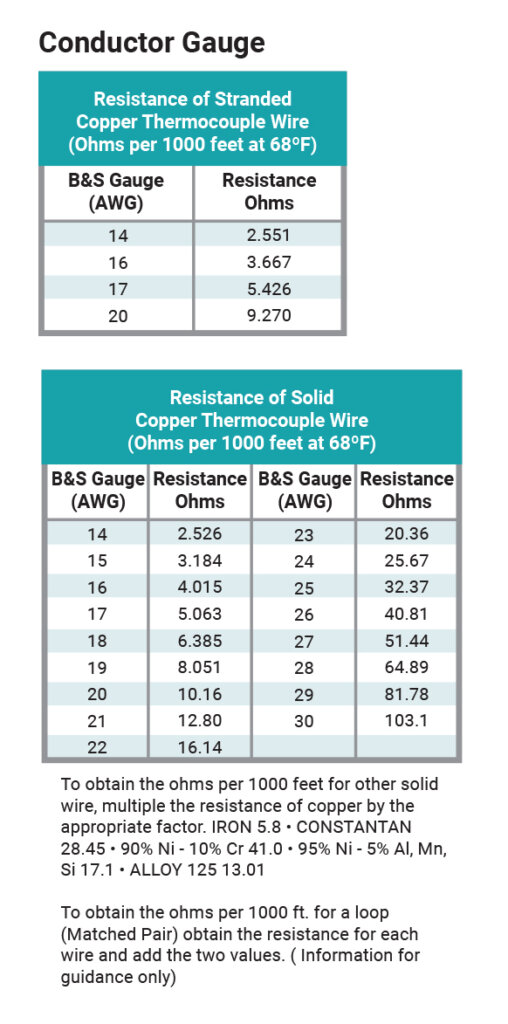

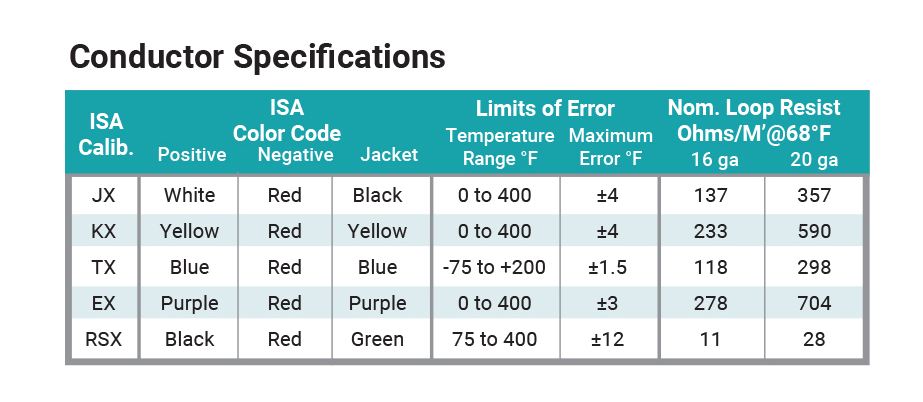
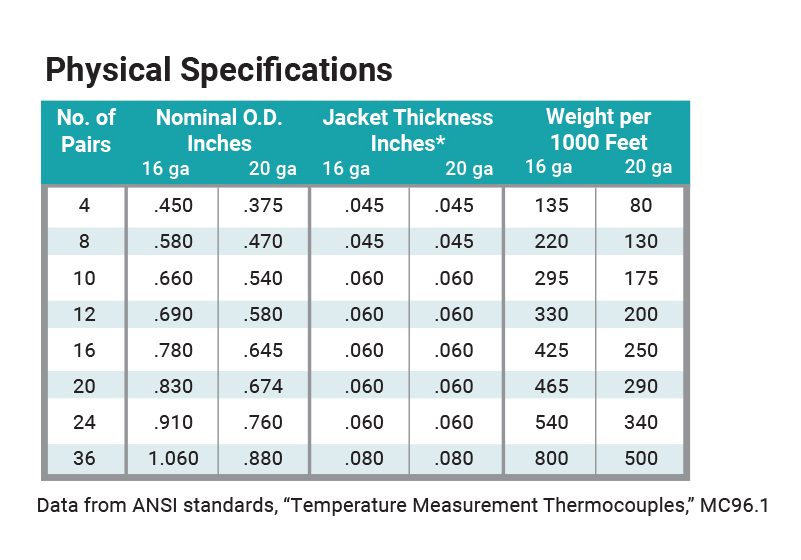
Step 1: Understanding the Range of Temperature Monitoring
Start by identifying the range of temperatures that your application will need to monitor. Different types of thermocouples are designed for specific ranges of temperatures.
Make an evaluation of where the thermocouple will be used. Important factors to consider are presence of corrosive materials, level of pressure, & any dynamic forces.
Step 2: Selection of Thermocouple Variant Tailored to Thermal and Environmental Demands
For instance, in scenarios demanding the monitoring of elevated temperatures, a Type K thermocouple could be optimal, whereas Type T is better aligned with cooler temperature monitoring.
Use a chart that compares different types of thermocouples, showing their temperature handling abilities and how well they withstand various environmental conditions.
Step 3: Insulation Type Determination Predicated on Surrounding Conditions
Should the wire be subject to corrosive elements, PTFE insulation should be contemplated.
In environments of intense heat, the application of ceramic insulation is advised.
Step 4: Accuracy Necessities and Grade Determination
For applications of a general nature, standard grade wires suffice. However, for precision-critical applications, opt for wires with Special Limits of Error (SLE).
Consult a detailed chart delineating the precision variances between standard and SLE wires.
Step 5: Wire Length Calculation
Measure the span between the thermal probe and the instrument that records temperature.
Account for potential signal degradation due to extended wire length and the presence of electromagnetic disturbances. Shielded wiring may be requisite in such instances.
Step 6: Engage with Wire Specialists
Initiate dialogue with wire specialists, providing them with your detailed requirements to garner tailored advice or to commission bespoke thermocouple wiring solutions.
Step 7: Assessment and Acquisition
With a complete set of data at your disposal, meticulously evaluate your options to confirm they align with your operational criteria.
Secure your purchase through a vendor with a track record of excellence and dependability to guarantee the integrity and performance of your thermocouple wire.
Thermocouple wires are available in different types, such as type J, type K, and type T, among others. Each thermocouple type has a specific temperature range and accuracy. Therefore, it’s important to select the right type of thermocouple wire for the temperature range required for the application.
Features & Benefits of Thermocouple Wire
Thermocouple wires offer several features and benefits, including high accuracy, reliability, and flexibility. They are suitable for measuring temperatures in harsh environments and can withstand high temperatures. In addition, they are cost-effective and can be customized to fit specific applications.
The Positive & Negative of Thermocouple Wire
Thermocouple wires have a positive and negative side, which is determined by their material composition. Common guidelines, the negative lead in insulated thermocouple wire is red and the positive lead has the color of the thermocouple. It’s important to connect the thermocouple wires correctly to ensure accurate temperature measurement.
Wire and Multi-Conductor Cable Specifications for Thermocouple Circuits
- Each conductor calibrated and matched to ANSI standards C96.1 -1969.
- Each conductor insulated with 15 mils 105 ° C PVC.
- Each pair is numbered and twisted for magnetic noise rejection.
- Lay of twist staggered 1 ½ to 2½” to allow compact cabling.
- Stranded 22-gauge copper communications wire with15 mils black PVC
- Cable shielded 100 with 2.35 mil aluminized Mylar* tape in continuous contact with a bare 20-gauge copper drain wire for maximum electrostatic noise rejection and ease of contacting the cable shielding.
- Jacketed overall with rugged, hi-temp 105 ° C PVC, thickness and color.
General Jacket Information
Wire jackets provide protection: Wire jackets act as a protective layer around electrical wires, shielding them from external factors such as moisture, abrasion, and flames. They help prevent damage to the wires and ensure safe and reliable operation.
Wire jackets resist environmental conditions. High-quality wire jackets are designed to withstand a wide range of environmental conditions. They can resist temperature extremes, UV radiation, chemicals, and other elements, making them suitable for various applications and industries.
Wire jackets prevent interference. Wire jackets can prevent interference from conductor and ground loops, reducing the risk of signal degradation and electrical noise. They help maintain signal integrity and ensure accurate transmission of electrical signals.
The hi-temp 105 ° C PVC jacket of Temp-Pro’s thermocouple extension grade wire is resistant to fungus, flames, abrasion and moisture and will prevent interference from conductor and ground loops. The jacket will withstand a great deal of abuse from aging, flexing and sunlight and will be unaffected by temperatures between -40 ° F and +220 ° F.
Conclusion
Thermocouple wire is an essential tool for temperature sensing in various industries. It offers high accuracy, reliability, and flexibility, making it suitable for harsh environments and critical temperature measurement applications. Understanding the differences between thermocouple probes and wires, error limits, insulation, and grade types is crucial for selecting the right thermocouple wire for an application. By considering these factors carefully, users can ensure accurate temperature measurement and avoid costly errors in their processes.
Achieve extraordinary feats with a trusted partner who truly understands your goals.
For over 50 years, Temp-Pro has been a driving force behind countless innovations, delivering custom temperature sensors that surpass international standards. Temp-Pro manufactures the most dependable thermocouples, contact us today at (800)-991-9093 to request a quote and experience the unrivaled excellence that sets us apart.

